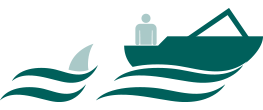You are on a boat tour watching sharks, looking at a great white shark swimming around your boat. The great white shark is big, strong and fierce, and just one bite would seriously hurt you. This means the great white is very hazardous.
Solvent risk management
Solvents are powerful chemicals, made to efficiently remove unwanted residues from your metal parts. And because they are so powerful, they need to be handled with care. On this page, we will show you what the difference between hazard and risk is and how to properly handle solvents to be virtually risk-free.
Hazard is not risk
Even though many people use hazard and risk synonymously, their meanings are significantly different.
Hazard (or danger) describes something's capability to cause harm. Risk, on the other hand, describes the likelihood of harm occurring.

As an example:

Good thing you are on a boat! The shark cannot reach you and therefore cannot hurt you at all. This means – as long as you are on the boat – the likelihood of the shark hurting you is low, even though the shark itself is highly hazardous.
And now, let’s imagine you were to jump over board for a little swim. In this case, there is nothing between you and the shark any more and you would very likely get hurt. That would be bad risk management.

Risk management eliminates risk
For one last time, let's go back to our shark example to explain risk management. The function of risk management is to eliminate risk.
In our case, a very simple way to eliminate any shark risk would be to eliminate the sharks. Unfortunately, that would also be terrible for biodiversity and for the shark-watching business. So, even though the risk would be eliminated, the trade-off would be unacceptable.
A better way would be to make it impossible for shark-watching customers to jump over board. Because then, you can have both: sharks and safety.
Ok, so now I know how to safely run a shark watching business. Now tell me about solvents.
Good risk management for using solvents is an interplay of protective measures, risk awareness, staff training and reliable service partners.
Protective measures
1. ENGINEERING MEASURES
The best way to reduce the likelihood of harm happening is to avoid it physically via an engineered system. The cleaning chamber of modern cleaning equipment will not open until virtually all the solvent vapour has been removed. The SAFE-TAINER™ System connects exclusively with the fitting accessory, so solvent remains in the hermetically closed loop system.
2. ADMINISTRATIVE MEASURES
Organizational measures are also a key risk management step. Clear indications of the hazards/risks and how to manage them should be visible. Employees involved directly, indirectly or even just geographically should be aware of the risks and good practices.
3. PERSONAL PROTECTIVE EQUIPMENT
Personal Protective Equipment is the "last barrier". Operators should be aware of the right level of personal protection to wear in which situation.
Risk Awareness
Be aware of the risk at all times. No matter which cleaning media you are using, what exactly your task is or which product you are using, any chemical can cause harm if not handled properly. Please stay safe and always take the time to read the Material Safety Data Sheet (MSDS) of a chemical product before handling it. It provides all the relevant information.
› Please contact us or your distribution partner for your specific MSDS.
Solvent Training
In a CHEMAWARE™ Solvent Training, you will learn how to improve the safety and sustainability of your cleaning process. By applying this knowledge, your process can be optimized. Reliable and high-quality cleaning results can be achieved.
You will learn how to implement:
A SAFER WORKPLACE
- Viable risk management measures in handling solvents
- Protection of operators
A RELIABLE CLEANING OPERATION
- Solvent management to meet your requirements regarding component cleanliness and throughput
- Protection of your cleaning equipment investment
LEGAL CONFORMITY & ENVIRONMENTAL COMPLIANCE
- Applicable laws and regulations to comply with
You will benefit from a balanced training covering the theoretical background and a hands-on demonstration at your site including a question & answer session. At the end of the training, a certificate for completion of the training will be handed out to the participants.
Exposure Measurement Services
The CHEMAWARE™ Exposure Measurement Service is offered to help you with measuring and monitoring your worker's Time Weighted Average (TWA) exposure to solvents. It is part of recommended EH&S actions and enables the implementation of better risk management measures for worker safety with solvents.
The CHEMAWARE™ Exposure Measurement Service is a package composed of a box of 10 activated carbon adsorption badges for day-long exposure measurement and up to 10 analyses of the sampling badges by a third-party independent laboratory.
Emergency responses
In the unlikely event of a leakage, here are some fast and appropriate actions to immediately protect employees and the environment:
Small Leakages
- Maintain proper protective equipment
- Contain the spill
- Stop the leak using proper protective equipment and ventilation
- Clean up small spills and leaks immediately
- Place solvent-laden materials and/or binders in a covered, solvent-resistant metal container
- Arrange for waste disposal
- Contact the supervisor, even for small spills and leaks
Protect people
- Evacuate area
- Keep staff out of low areas
- Keep staff out of confined or poorly ventilated areas
- Keep upwind of the spill
- Ventilate the area of leak or spill
- Only trained and properly protected staff should be involved in clean-up operations
- Confined space entry procedures must be followed before entering the area
- Use appropriate safety equipment
› Download a printable version of the Quick Action Sheet here.